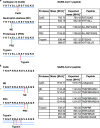Neutrophil Elastase and Proteinase 3 Cleavage Sites Are Adjacent to the Polybasic Sequence within the Proteolytic Sensitive Activation Loop of the SARS-CoV-2 Spike Protein
- PMID: 33748632
- PMCID: PMC7970549
- DOI: 10.1021/acsomega.1c00363
Neutrophil Elastase and Proteinase 3 Cleavage Sites Are Adjacent to the Polybasic Sequence within the Proteolytic Sensitive Activation Loop of the SARS-CoV-2 Spike Protein
Abstract
Serine proteases neutrophil elastase (NE), protease 3 (PR3), cathepsin G (CatG), and neutrophil serine protease 4 (NSP4) are released by activated neutrophils swarming around the place of pathogen invasion to provoke an immune response. However, uncontrolled proteolytic activity of proteases results in various human diseases, including cardiovascular diseases, thrombosis, and autoimmunity. In addition, proteases can be hijacked by several viruses to prime virus-derived surface proteins and evade immune detection by entering into the host cell. Indeed, porcine elastase increases the suitability of host cells to be infected by SARS-CoV-1. We compared the cleavage sites of human NE, PR3, and CatG as well as porcine-derived trypsin within the amino acid sequence of the proteolytic sensitive activation loop at the interface of S1/S2 of the spike protein (S protein) of SARS-CoV-1 as well as SARS-CoV-2. As a result, NE and PR3, but not CatG, hydrolyze the scissile peptide bond adjacent to the polybasic amino acid sequence of the S1/S2 interface of SARS-CoV-2, which is distinctive from SARS-CoV-1. These findings suggest that neutrophil-derived NE and PR3 participate in priming of the S1/S2 interface during an immune response.
© 2021 The Authors. Published by American Chemical Society.
Conflict of interest statement
The authors declare no competing financial interest.
Figures


Similar articles
-
Variation of Proteolytic Cleavage Sites towards the N-Terminal End of the S2 Subunit of the Novel SARS-CoV-2 Omicron Sublineage BA.2.12.1.Molecules. 2022 Sep 8;27(18):5817. doi: 10.3390/molecules27185817. Molecules. 2022. PMID: 36144551 Free PMC article.
-
Occurrence of a novel cleavage site for cathepsin G adjacent to the polybasic sequence within the proteolytically sensitive activation loop of the SARS-CoV-2 Omicron variant: The amino acid substitution N679K and P681H of the spike protein.PLoS One. 2022 Apr 18;17(4):e0264723. doi: 10.1371/journal.pone.0264723. eCollection 2022. PLoS One. 2022. PMID: 35436320 Free PMC article.
-
Camostat Does Not Inhibit the Proteolytic Activity of Neutrophil Serine Proteases.Pharmaceuticals (Basel). 2022 Apr 20;15(5):500. doi: 10.3390/ph15050500. Pharmaceuticals (Basel). 2022. PMID: 35631327 Free PMC article.
-
Activity-Based Probes to Utilize the Proteolytic Activity of Cathepsin G in Biological Samples.Front Chem. 2021 Feb 25;9:628295. doi: 10.3389/fchem.2021.628295. eCollection 2021. Front Chem. 2021. PMID: 33732686 Free PMC article. Review.
-
Hindrance of the Proteolytic Activity of Neutrophil-Derived Serine Proteases by Serine Protease Inhibitors as a Management of Cardiovascular Diseases and Chronic Inflammation.Front Chem. 2021 Nov 15;9:784003. doi: 10.3389/fchem.2021.784003. eCollection 2021. Front Chem. 2021. PMID: 34869231 Free PMC article. Review.
Cited by
-
Synergistic activation of bat SARS-like coronaviruses spike protein by elastase and TMPRSS2.Sci Rep. 2025 Jul 21;15(1):26469. doi: 10.1038/s41598-025-11600-y. Sci Rep. 2025. PMID: 40691229 Free PMC article.
-
In silico analysis of mutations near S1/S2 cleavage site in SARS-CoV-2 spike protein reveals increased propensity of glycosylation in Omicron strain.J Med Virol. 2022 Sep;94(9):4181-4192. doi: 10.1002/jmv.27845. Epub 2022 Jun 7. J Med Virol. 2022. PMID: 35575289 Free PMC article.
-
Neutrophil proteases are protective against SARS-CoV-2 by degrading the spike protein and dampening virus-mediated inflammation.JCI Insight. 2024 Apr 8;9(7):e174133. doi: 10.1172/jci.insight.174133. JCI Insight. 2024. PMID: 38470488 Free PMC article.
-
Variation of Proteolytic Cleavage Sites towards the N-Terminal End of the S2 Subunit of the Novel SARS-CoV-2 Omicron Sublineage BA.2.12.1.Molecules. 2022 Sep 8;27(18):5817. doi: 10.3390/molecules27185817. Molecules. 2022. PMID: 36144551 Free PMC article.
-
Circulating biomarkers of inflammaging as potential predictors of COVID-19 severe outcomes.Mech Ageing Dev. 2022 Jun;204:111667. doi: 10.1016/j.mad.2022.111667. Epub 2022 Mar 25. Mech Ageing Dev. 2022. PMID: 35341896 Free PMC article. Review.
References
LinkOut - more resources
Full Text Sources
Other Literature Sources
Molecular Biology Databases
Research Materials
Miscellaneous

